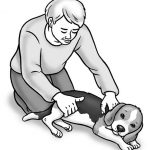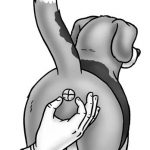 In This Chapter
In This Chapter- Uncovering common Beagle ownership goofs
- Avoiding Beagle ownership boo-boos
Raising a Beagle puppy or adult dog can be a real challenge. No matter how much you want to do the job right, an unprepared owner can find plenty of ways to bungle the job. Some of these ownership goofs result from a lack of owner understanding; others are a result of owner impatience with this utterly adorable but occasionally exasperating Snoopy-dog.
Either way, many mistakes humans make with Beagles are avoidable — if the humans know ahead of time what those mistakes are likely to be. This chapter describes how and why people goof up Beagle ownership, and how you can avoid making such mistakes.
Not Doing Your Homework
The Beagle’s big winsome eyes, long floppy ears, and sweet little snouts are guaranteed heart-melters. That said, you shouldn’t let your heart melt to the point of buying or adopting a Beagle until you learn more about the breed first. Then you can decide whether this endearing breed really is right for you.
Chapter
The Incredible, Lovable Beagle offers much of the info you need to determine whether a Beagle is likely to be the dog of your dreams — or not. For example, if you live in an apartment, you might want to think twice about bringing a Beagle into your domicile. The reason: Beagles are vocal individuals, given to barking and other vocalizing that is likely to make you a tad unpopular with your neighbors.
Taking the time now to read up on all things Beagle will save you a ton of hassle and disappointment in the future.
Choosing Too Quickly
You’ve done your homework, and you’ve decided that a Beagle is exactly the right dog for you. You’re sure you know what the next step is: getting a Beagle now.
Not so fast.
When you’re choosing a Beagle, haste leads to heartbreak. A refusal to delay gratification can lead you to choose a less-than-healthy Beagle from a way-far-from-ideal source. Chapter
Gonna Find Me a Beagledetails those sources, such as the Internet and certain types of pet stores. The chapter also explains why other sources, such as backyard breeders and classified ads, are sources not only to question but to avoid.
Tip
Play it safe and stick with a puppy or adult from trustworthy sources, such as a reputable breeder, an animal shelter, or a rescue group. Getting the right Beagle from a place you can trust is worth every day, week, or month you may have to wait.
Bypassing the Crate
The sight of your irrepressible Beagle running around in your fenced yard or tearing down the hallway of your house may cause you to have second thoughts about using a crate to teach him where he shouldn’t run or deposit his business. You may wonder whether putting this carefree creature into a crate is cruel. You may feel that a crate is nothing more than a doggy prison. You may even fear that anyone who visits your house and sees your crated Beagle will summon a band of Animal Cops to your home to cite you for mistreating your beloved pooch.
Never fear. You’re not being cruel. You’re not becoming a warden for Beagle prison. And the only thing an Animal Cop would cite you for is for being a good Beagle owner.
Chapters
Preparing for Your Beagle’s Arrival and
Housetraining Your Beagle explain that a crate can be a Beagle’s best friend. The crate taps into a dog’s instinctive desire to live in a small den and to keep that den clean. A healthy Beagle won’t pee or poop in his den if he can avoid doing so. A Beagle who’s accustomed to a crate is likely to be a Beagle who’s got a leg up (yes, that pun was intended!) on the uncrated Beagle when it comes to housetraining.
Here’s another benefit from crate-training your Beagle: By escorting him to his little sanctuary whenever you leave the house, you can be sure that your house will be spared the ravages of Beagle mischief-making. Your furniture, carpets, and other possessions will be unmolested by Beagle claws and teeth.
Making housetraining easier, keeping your Beagle out of trouble, and sparing your stuff . . . what’s not to like? Bypassing those benefits by eschewing the crate is a major mistake — a mistake that you don’t need to make.
Expecting Housetraining to Be Easy
Although crates can make Beagle housetraining easier, teaching proper bathroom behavior to a Beagle still is no piece-of-cake enterprise. The reason is not that Beagles are stupid — they certainly aren’t. They just have other priorities.
The ever-confident Snoopy-dog also can be stubborn, and that stubbornness may be reflected in a reluctance to do his business where and when you want him to. The Beagle also is known for his single-minded interest in following a scent to wherever that scent may take him and for his nose’s ability to detect the faintest possible fragrance. Those characteristics mean that you need to be determined and consistent in teaching your dog proper potty protocol, no matter how uninterested he may act. You also must be fanatical about thoroughly cleaning up after any bathroom mistakes. The slightest trace of bodily waste residue on a carpet or floor guarantees that the Beagle will return to the scene of his crime and commit that crime again.
Remember
But like just about any dog, Beagles can be housetrained. As Chapter Housetraining Your Beagle explains, the keys to housetraining success are absolute consistency, abundant patience, and, yes, a good crate.
Failing to Be Vigilant
Did you fail to put one of your socks in the clothes hamper? Kiss that sock goodbye; your Beagle made off with it as soon as it hit the ground. Did you leave your ham sandwich on the coffee table while you went to answer the doorbell? The likelihood of that sandwich still being on that table when you return is zero. Did you let your Beagle puppy explore the house on his own before he was fully housetrained? Start looking for a puddle or pile now. I can safely guarantee that you will find at least one, maybe even both.
Until you can count on your Beagle not to use your living room as his own personal potty, don’t let him wander through your house without you keeping an eagle eye on him for signs that he’s planning to do his business. And never assume that your Beagle will stay out of your stuff. Instead, assume that he won’t — and prevent any problems by keeping your stuff way beyond his reach.
Thinking That Your Beagle Is a Person
You come home from a hard day at the office and there in your vestibule is a little pile or puddle of you-know-what. Nearby, your Beagle sits, hanging his head. “Aha!” you think. He knows he’s done wrong. You proceed to scold your four-legged friend, and you feel sure that his apparent guilt plus your lecture will persuade him to never, ever leave such a present for you again.
Think again.
Dogs experience many feelings, but guilt is not one of them. Your Snoopy-dog’s woebegone demeanor probably results from previous homecomings in which you lectured him. He did not and will not connect your scolding with his bathroom boo-boo. Heck, he’s forgotten that he even did it.
Unlike people, pooches such as Beagles do not feel guilt over that bad behavior, nor do they engage in such behavior for spite. They just do what they do unless they have the incentive to do something else. With the training tips offered in Part IV, you can provide that incentive and have a better-behaved Beagle.
Doing Things on the Cheap
Having a Beagle or any other canine companion doesn’t come without plenty of expenses: the adoption fee or purchase price, vet visits, spaying/neutering, food, dishes, toys, treats. . . The list may seem endless, particularly if you’re in a cash crunch. And you may be tempted to cut corners.
Maybe, for example, you think that you’ll save money if you opt for generic-brand supermarket dog food over higher-quality fare. Perhaps you can’t see the point of shelling out extra bucks for a stainless steel dish when plastic is so much cheaper. And if your Beagle gets yet another ear infection or another bout of diarrhea, you’re understandably tempted to just let it all go or try treating it yourself, rather than schlepping him back to the vet and whipping out the plastic yet again.
Warning!
The trouble is, being penny-wise is pound-foolish when you’re caring for your Beagle. The recurrent ear infection or diarrhea could be a food allergy or something more serious. The plastic dish may be cheaper but also may cause a perpetual rash on your Beagle’s chin. The cheap food may actually end up being more expensive than the pricey stuff because your dog needs more of the inexpensive brand to get the nutrition he needs.
Nobody is saying that you need to outfit your Beagle in a designer raincoat or rhinestone collar to give him a high-quality life. (Although if you want to and can afford to do so, that’s your privilege, of course.) But investing the upfront money to take good care of your Snoopy-dog will pay off big time in good health, better behavior, and fewer visits to your vet’s office in the long run. Chapter
Preparing for Your Beagle’s Arrival and Part III explain how.
Thinking That Your Beagle Can Train Himself
Beagles are multitalented dogs. Some have excelled on the agility field or at the obedience trial. Others shine in the hospital ward as therapy dogs. Still others ferret out rabbits and other game. Even more locate illegally imported fruit and vegetables at busy airports. And even your own Snoopy-dog can learn to come when called, sit when told, and potty when and where he’s supposed to.
However, he can’t teach himself any of these maneuvers. He needs someone to teach him. Who better than you, his beloved human? At the very least, take the time to teach your Beagle basic good manners — and, if all goes well, think about showing him some advanced maneuvers. Chapters
Housetraining Your Beagle and
Schooling Your Beagle give you the lowdown on teaching basic Beagle etiquette, and Chapter
Rehabbing the Delinquent Beagle offers pointers on remedial training for the Beagle with learning issues. For the Beagle who’s ready for bigger and better things, Chapter
Getting Physical: Exercising Your Beagle describes sports that Snoopy-dogs can excel in.
Playing Doctor
The Beagle, like all other dogs, is a marvelously complicated creature. His body works because his muscular, skeletal, digestive, circulatory, nervous, and immune systems — to name just a few — work together to keep him healthy and active. When one or more of those systems goes awry, your Beagle gets sick.
Although you need to pay close attention to your Beagle’s health and behavior, when he does get sick (and he will, no matter how hard you work to keep him well), you can’t cure him yourself. He needs professional help from his very own doctor: your veterinarian. Tell the vet everything you know about your Beagle’s condition, share your ideas, and advocate for your Beagle when necessary, but know that your vet has the training to put your pooch on the path back to wellness.
Thinking That You Are More Important Than Bunnies
Your Beagle loves you. Count on it. He knows that you are the Giver of All Good Things, including great grub, tons of affection, and a warm, soft place to sleep. In his eyes, you are the most wonderful two-legged individual he has ever met. He may not always come when he’s called, but that doesn’t mean he is rejecting you in any way. He just has different priorities, that’s all.
Those priorities are chasing rabbits, squirrels, and perhaps other interesting four-legged critters — and the drive to engage in such pursuits is hard-wired into your Beagle’s psyche. As Chapter
The Incredible, Lovable Beagle explains, Beagles were developed for the express purpose of chasing down the real-life versions of Bugs Bunny and Rocket J. Squirrel. Put a fluffy- or cotton-tailed critter in front of a Beagle, and that Beagle will appear to forget that his beloved owner exists. You can’t take such amnesia personally. This behavior is not about you.
To keep your Beagle safe, you need to recognize that squirrels, bunnies, and other instinct-triggering critters and smells are very likely to supercede your dog’s desire to please you. Thus, you need to keep your Beagle on a leash or in a securely fenced yard, so if a local cotton-tailed burrower or fluffy-tailed tree dweller happens to amble onto the Beagle’s turf, he can chase that critter without dashing into the street and into the path of a speeding car. True, the fence or leash will limit the likelihood of the Beagle actually catching the critter — but the journey, not the destination, is what counts.
by Susan McCullough
































